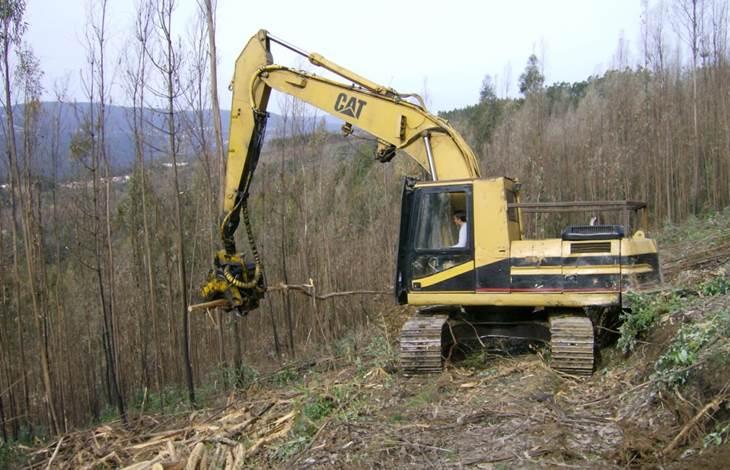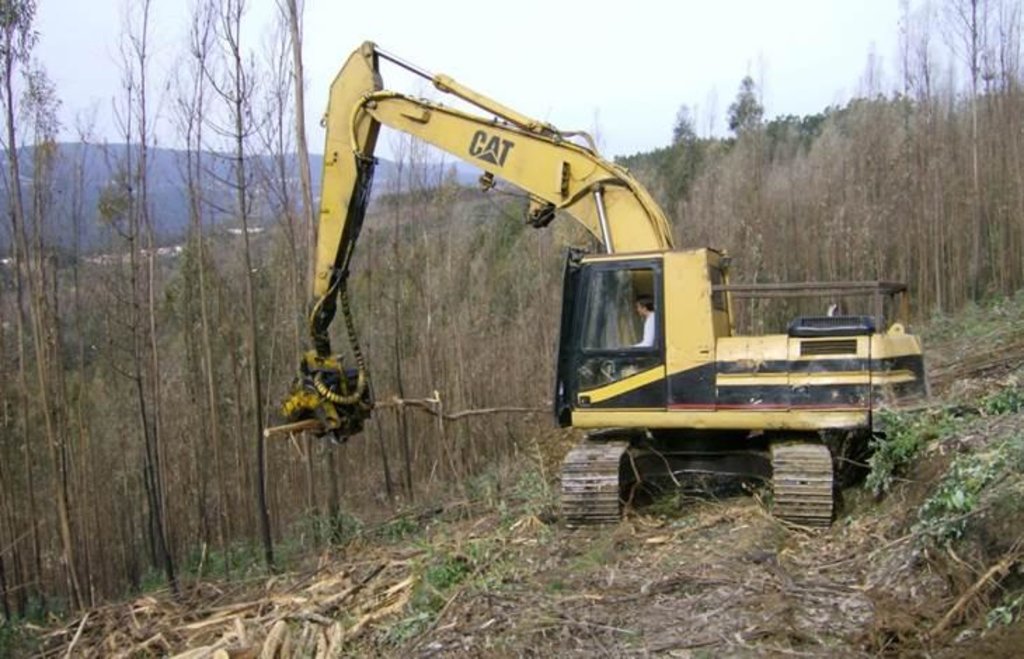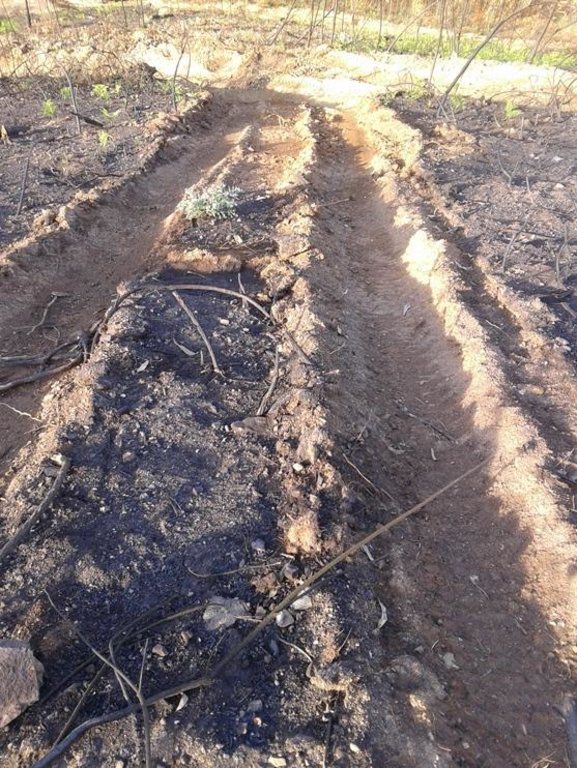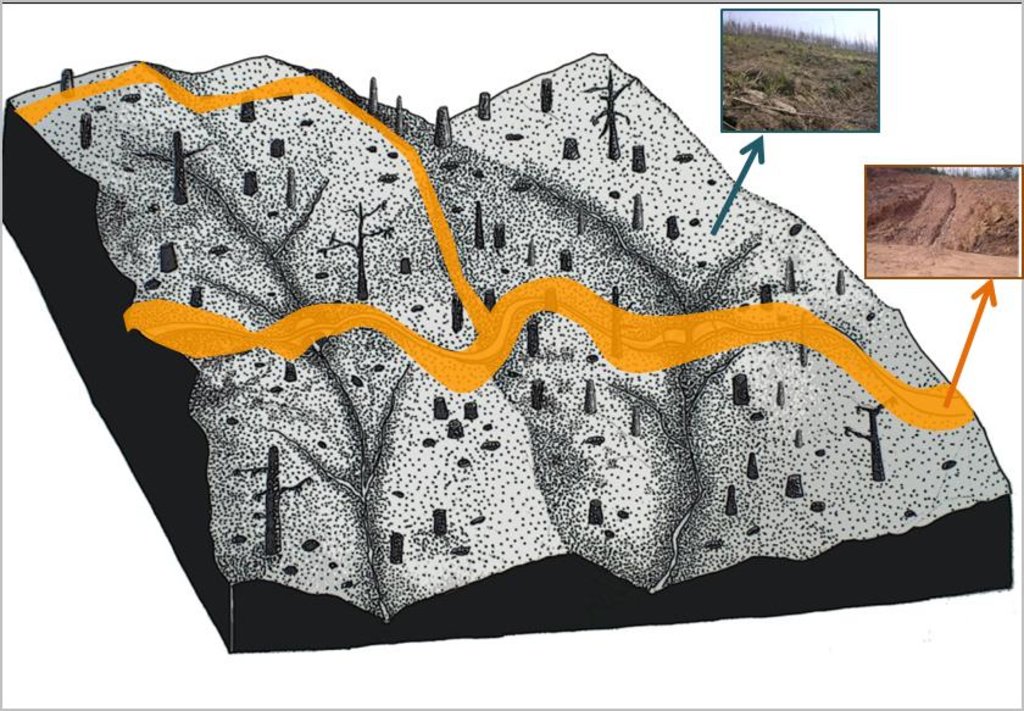Post-fire salvage logging; post-fire traditional logging [Portugal]
- Création :
- Mise à jour :
- Compilateur : Maruxa Malvar Cortizo
- Rédacteur : –
- Examinateurs : Fabian Ottiger, Alexandra Gavilano
Extração material lenhoso pos-incêndio
technologies_1713 - Portugal
Voir les sections
Développer tout Réduire tout1. Informations générales
1.2 Coordonnées des personnes-ressources et des institutions impliquées dans l'évaluation et la documentation de la Technologie
Spécialiste GDT:
Spécialiste GDT:
Spécialiste GDT:
Keizer Jan Jacob
Centre for Environmental and Marine Studies (CESAM) - Department of Environment and Planning-University of Aveiro
Portugal
Nom du ou des institutions qui ont facilité la documentation/ l'évaluation de la Technologie (si pertinent)
University of Aveiro (University of Aveiro) - Portugal1.3 Conditions relatives à l'utilisation par WOCAT des données documentées
Le compilateur et la(les) personne(s) ressource(s) acceptent les conditions relatives à l'utilisation par WOCAT des données documentées:
Oui
2. Description de la Technologie de GDT
2.1 Courte description de la Technologie
Définition de la Technologie:
Post-fire salvage logging is the practice of harvest the trees after fire, the employed methodology is clearcutting which involves the cut of essentially all the trees and the removal of logging residues.
2.2 Description détaillée de la Technologie
Description:
In the 2015 summer a wildfire affected the Semide mountain range nearby the Lousã massif, central Portugal. The area was afforested with eucalypt and pine plantations during last XX century and nowadays landscape is composed mainly by eucalypts at different stages of development and, the understory shrub vegetation.
The research team of the University of Aveiro set up an experiment to test the effect of post-fire logging in soil erosion and other selected soil properties.
Purpose of the Technology: Post-fire logging is a common management practice usually undertaken to recover burnt timber resources, to plant new seedlings and to reduce possible insect infestation hazard. In Portugal, about 10x106 m3 of timber could be harvested every year and a considerable percentage of this figure comes from recently burned eucalypt and pine stands.
Post-fire logging could have a multiple detrimental effect on ecosystem as fire-affected ecosystems are sensitive to further disturbance. This multiplier effect concerns soil compaction, soil (fertility) losses, with serious implications for in-situ plant growth, soil biota and for downstream aquatic systems. Furthermore, post-fire logging undermines the effectiveness of costly rehabilitation efforts aimed at reducing soil erosion. Hence, the post-fire logging practice is still controversial in terms of economic benefit and environmental consequences, in many parts of the world.
Establishment / maintenance activities and inputs: The standard logging technique consists of felling burned trees either with a harvester or manually with a chainsaw depending on slope conditions and machinery available. The logs will be gathered with the harvester, using a cable-skidder or pulling logs down-slope with a cable attached to a tractor. A forwarder will transport them to the main pile prior to load and removal by trucks.
The slope will present two well differenced units according to soil surface disturbance, the skid trail or the logged area.
Natural / human environment: The eucalypt trees in the region are typically planted as monocultures for paper pulp production, and harvested every 7-14 years. The landscape reflects a long history of intense land management, with a mosaic of (semi-)natural and man-made agricultural and afforested lands. Since the 1980´s, however, wildfires have increased dramatically in frequency and extent, aided by a general warming and drying trend but driven primarily by socio-economic changes.
2.3 Photos de la Technologie
2.5 Pays/ région/ lieux où la Technologie a été appliquée et qui sont couverts par cette évaluation
Pays:
Portugal
Région/ Etat/ Province:
Coimbra
Autres spécifications du lieu:
Coimbra
Spécifiez la diffusion de la Technologie:
- répartie uniformément sur une zone
S'il n'existe pas d'informations exactes sur la superficie, indiquez les limites approximatives de la zone couverte:
- < 0,1 km2 (10 ha)
Commentaires:
The studied area is a hillslope scale but total logged area is larger
2.6 Date de mise en œuvre de la Technologie
Si l'année précise est inconnue, indiquez la date approximative: :
- il y a plus de 50 ans (technologie traditionnelle)
2.7 Introduction de la Technologie
Spécifiez comment la Technologie a été introduite: :
- dans le cadre d'un système traditionnel (> 50 ans)
3. Classification de la Technologie de GDT
3.2 Type(s) actuel(s) d'utilisation des terres, là où la Technologie est appliquée

Forêts/ bois
- Plantations d'arbres, boisements
Produits et services:
- Bois d'œuvre (de construction)
- Bois de chauffage
Commentaires:
Major land use problems (compiler’s opinion): Strong increases in runoff and erosion should be a main land management concern following wildfires, as they constitute a serious threat to land-use sustainability and downstream aquatic habitats and human infrastructures. In addition to fire itself, post-fire logging activities can greatly increase erosion response of recently burnt areas. Furthermore, logging is typically the most common practice after fire, and recently burnt soils are more erodible than long-unburnt soils.
Major land use problems (land users’ perception): Loss of wood resources and productivity.
Plantation forestry: Yes
Forest products and services: timber, fuelwood
Number of growing seasons per year: 3
Longest growing period in days: 270Longest growing period from month to month: September to May
3.5 Groupe de GDT auquel appartient la Technologie
- gestion des forêts naturelles et semi-naturelles
- gestion des plantations forestières
- Post-fire logging
3.6 Mesures de GDT constituant la Technologie

pratiques agronomiques
- A1: Couverture végétale/ du sol

pratiques végétales
- V3: Défrichement de la végétation

modes de gestion
- M7: Autres
Commentaires:
Main measures: management measures
Specification of other management measures: Recover burnt timber resources and improve the re-sprout of new eucalypts
3.7 Principaux types de dégradation des terres traités par la Technologie

érosion hydrique des sols
- Wt: perte de la couche superficielle des sols (couche arable)/ érosion de surface

dégradation physique des sols
- Pc: compaction

dégradation biologique
- Bc: réduction de la couverture végétale
- Bf: effets néfastes des feux
Commentaires:
Main type of degradation addressed: Wt: loss of topsoil / surface erosion, Pc: compaction, Bc: reduction of vegetation cover, Bf: detrimental effects of fires
Main causes of degradation: soil management (Eucalypt plantations are prone to forest fires), crop management (annual, perennial, tree/shrub) (Logging increases soil erosin risk and soil compactation), deforestation / removal of natural vegetation (incl. forest fires) (Logging increases the lost of vegetation cover), population pressure (Since the 1980´s, eucalypt plantations increased greatly, driven primarily by socio-economic changes.)
3.8 Prévention, réduction de la dégradation ou réhabilitation des terres dégradées
Spécifiez l'objectif de la Technologie au regard de la dégradation des terres:
- réduire la dégradation des terres
Commentaires:
Secondary goals: mitigation / reduction of land degradation
4. Spécifications techniques, activités, intrants et coûts de mise en œuvre
4.1 Dessin technique de la Technologie
Spécifications techniques (associées au dessin technique):
The slope will present two well differentiated units according to soil surface disturbance, the machinery trail and the logged area. The soil erosion risk will be associated with the loss of ground cover due to mechanical disturbance. Furthermore, the machinery trail presents the risk of concentrated overland-flow with the subsequent rill formation.
Location: Semide. Coimbra
Technical knowledge required for field staff / advisors: low
Technical knowledge required for land users: low (The use of machinery is preferable but not essential)
Main technical functions: control of dispersed runoff: retain / trap, control of concentrated runoff: impede / retard, improvement of ground cover, improvement of surface structure (crusting, sealing), sediment retention / trapping, sediment harvesting
Secondary technical functions: control of raindrop splash, improvement of subsoil structure (hardpan)
Other type of management: Recover burnt timber resources and improve the re-sprout of eucalypt stumps
Auteur:
Malvar,M.C.
4.2 Informations générales sur le calcul des intrants et des coûts
autre/ monnaie nationale (précisez):
euros
Indiquez le taux de change des USD en devise locale, le cas échéant (p.ex. 1 USD = 79.9 réal brésilien): 1 USD = :
0,92
Indiquez le coût salarial moyen de la main d'œuvre par jour:
60.87
4.3 Activités de mise en place/ d'établissement
| Activité | Calendrier des activités (saisonnier) | |
|---|---|---|
| 1. | 1 person with chainsaw | 24 |
| 2. | Harvester transport ( in a radio of 50 km)Harvester working (with person)Forwarder (with person)Final transport (in a radio of 50 km) | 60 |
4.4 Coûts et intrants nécessaires à la mise en place
| Spécifiez les intrants | Unité | Quantité | Coûts par unité | Coût total par intrant | % du coût supporté par les exploitants des terres | |
|---|---|---|---|---|---|---|
| Main d'œuvre | Labour | ha | 1,0 | 1461,0 | 1461,0 | |
| Equipements | Machine use | ha | 1,0 | 5870,0 | 5870,0 | |
| Coût total de mise en place de la Technologie | 7331,0 | |||||
| Coût total de mise en place de la Technologie en dollars américains (USD) | 7968,48 | |||||
4.6 Coûts et intrants nécessaires aux activités d'entretien/ récurrentes (par an)
Commentaires:
The prices were determined for a clearcutting of a slope with acceptable slope degree and accessibility. Prices were calculated by hectare in winter 2015 for central Portugal.
4.7 Facteurs les plus importants affectant les coûts
Décrivez les facteurs les plus importants affectant les coûts :
Accessibility and steepness will raise the costs. The use of machinery is not a mandatory. Small land owners decrease the total cost by doing manual work with a family framework.
5. Environnement naturel et humain
5.1 Climat
Précipitations annuelles
- < 250 mm
- 251-500 mm
- 501-750 mm
- 751-1000 mm
- 1001-1500 mm
- 1501-2000 mm
- 2001-3000 mm
- 3001-4000 mm
- > 4000 mm
Zone agro-climatique
- humide
- subhumide
Thermal climate class: subtropics
Thermal climate class: temperate
5.2 Topographie
Pentes moyennes:
- plat (0-2 %)
- faible (3-5%)
- modéré (6-10%)
- onduleux (11-15%)
- vallonné (16-30%)
- raide (31-60%)
- très raide (>60%)
Reliefs:
- plateaux/ plaines
- crêtes
- flancs/ pentes de montagne
- flancs/ pentes de colline
- piémonts/ glacis (bas de pente)
- fonds de vallée/bas-fonds
Zones altitudinales:
- 0-100 m
- 101-500 m
- 501-1000 m
- 1001-1500 m
- 1501-2000 m
- 2001-2500 m
- 2501-3000 m
- 3001-4000 m
- > 4000 m
5.3 Sols
Profondeur moyenne du sol:
- très superficiel (0-20 cm)
- superficiel (21-50 cm)
- modérément profond (51-80 cm)
- profond (81-120 cm)
- très profond (>120 cm)
Texture du sol (de la couche arable):
- grossier/ léger (sablonneux)
- moyen (limoneux)
Matière organique de la couche arable:
- abondant (>3%)
Si disponible, joignez une description complète du sol ou précisez les informations disponibles, par ex., type de sol, pH/ acidité du sol, capacité d'échange cationique, azote, salinité, etc.
Soil fertility is medium-high
Topsoil organic matter is high (afforested soils)
Soil drainage/infiltration is poor-medium ( Soil water repellency)
Soil water storage capacity is low (very shallow soils)
5.4 Disponibilité et qualité de l'eau
Profondeur estimée de l’eau dans le sol:
5-50 m
Disponibilité de l’eau de surface:
bonne
Qualité de l’eau (non traitée):
eau potable
Commentaires et précisions supplémentaires sur la qualité et la quantité d'eau:
Availability of surface water is good - medium (very dry summer)
5.5 Biodiversité
Diversité des espèces:
- faible
Commentaires et précisions supplémentaires sur la biodiversité:
Burnt soil
5.6 Caractéristiques des exploitants des terres appliquant la Technologie
Orientation du système de production:
- exploitation mixte (de subsistance/ commerciale)
- commercial/ de marché
Revenus hors exploitation:
- 10-50% de tous les revenus
Niveau relatif de richesse:
- pauvre
- moyen
Individus ou groupes:
- individu/ ménage
Genre:
- hommes
Indiquez toute autre caractéristique pertinente des exploitants des terres:
Land users applying the Technology are mainly common / average land users
Difference in the involvement of women and men: Harvesting forest areas is typically a men work, probably due to the machinery use and/or the physical strength needed.
Population density: 50-100 persons/km2
Annual population growth: < 0.5%
Market orientation of production system: subsistence (self-supply), mixed (subsistence/ commercial, commercial/ market
5.7 Superficie moyenne des terres utilisées par les exploitants des terres appliquant la Technologie
- < 0,5 ha
- 0,5-1 ha
- 1-2 ha
- 2-5 ha
- 5-15 ha
- 15-50 ha
- 50-100 ha
- 100-500 ha
- 500-1 000 ha
- 1 000-10 000 ha
- > 10 000 ha
Cette superficie est-elle considérée comme de petite, moyenne ou grande dimension (en se référant au contexte local)?
- petite dimension
Commentaires:
Average area of land owned or leased by land users applying the Technology: 2-5 ha, 5-15 ha, 15-50 ha
5.8 Propriété foncière, droits d’utilisation des terres et de l'eau
Propriété foncière:
- individu, sans titre de propriété
Droits d’utilisation de l’eau:
- communautaire (organisé)
5.9 Accès aux services et aux infrastructures
santé:
- pauvre
- modéré
- bonne
éducation:
- pauvre
- modéré
- bonne
assistance technique:
- pauvre
- modéré
- bonne
emploi (par ex. hors exploitation):
- pauvre
- modéré
- bonne
marchés:
- pauvre
- modéré
- bonne
énergie:
- pauvre
- modéré
- bonne
routes et transports:
- pauvre
- modéré
- bonne
eau potable et assainissement:
- pauvre
- modéré
- bonne
services financiers:
- pauvre
- modéré
- bonne
6. Impacts et conclusions
6.1 Impacts sur site que la Technologie a montrés
Impacts socio-économiques
Production
production de bois
diversité des produits
Commentaires/ spécifiez:
Promoves eucalypt monocultures
production d'énergie
Commentaires/ spécifiez:
Biomass
Revenus et coûts
diversité des sources de revenus
Impacts socioculturels
possibilités de loisirs
Commentaires/ spécifiez:
The logging of the burnt trunks arguably improves the esthetic value of the area, including by removing evidence of the fire
Improved livelihoods and human well-being
Commentaires/ spécifiez:
Yes, because timber production is a complementary income for many families in the region
Impacts écologiques
Cycle de l'eau/ ruissellement
qualité de l'eau
ruissellement de surface
évaporation
Sols
humidité du sol
couverture du sol
encroûtement/ battance du sol
compaction du sol
matière organique du sol/ au dessous du sol C
Biodiversité: végétale, animale
contrôle des animaux nuisibles/ maladies
Réduction des risques de catastrophe et des risques climatiques
risques d'incendies
vitesse du vent
Autres impacts écologiques
Soil erosion locally
Crop diversity
Habitat fragmentation
6.2 Impacts hors site que la Technologie a montrés
flux des cours d'eau fiables et stables en saison sèche
inondations en aval
envasement en aval
pollution des rivières/ nappes phréatiques
capacité tampon/de filtration
dommages sur les champs voisins
dommages sur les infrastructures publiques/ privées
6.3 Exposition et sensibilité de la Technologie aux changements progressifs et aux évènements extrêmes/catastrophes liés au climat (telles que perçues par les exploitants des terres)
Changements climatiques progressifs
Changements climatiques progressifs
| Saison | Augmentation ou diminution | Comment la Technologie fait-elle face à cela? | |
|---|---|---|---|
| températures annuelles | augmente | bien |
Extrêmes climatiques (catastrophes)
Catastrophes météorologiques
| Comment la Technologie fait-elle face à cela? | |
|---|---|
| pluie torrentielle locale | pas bien |
| tempête de vent locale | bien |
Catastrophes climatiques
| Comment la Technologie fait-elle face à cela? | |
|---|---|
| sécheresse | pas bien |
Catastrophes hydrologiques
| Comment la Technologie fait-elle face à cela? | |
|---|---|
| inondation générale (rivière) | bien |
Autres conséquences liées au climat
Autres conséquences liées au climat
| Comment la Technologie fait-elle face à cela? | |
|---|---|
| réduction de la période de croissance | pas bien |
6.4 Analyse coûts-bénéfices
Quels sont les bénéfices comparativement aux coûts de mise en place (du point de vue des exploitants des terres)?
Rentabilité à court terme:
légèrement positive
Rentabilité à long terme:
positive
Commentaires:
There is no maintenance
6.5 Adoption de la Technologie
Commentaires:
100% of land user families have adopted the Technology without any external material support
Comments on spontaneous adoption: Small land owners need to request the clearcutting to harvester companies; but they do it spontaneus
6.7 Points forts/ avantages/ possibilités de la Technologie
| Points forts/ avantages/ possibilités du point de vue de l'exploitant des terres |
|---|
|
Short-term economic benefits How can they be sustained / enhanced? Decrease wildfires will increase the economic value of the timber |
| Points forts/ avantages/ possibilités du point de vue du compilateur ou d'une autre personne ressource clé |
|---|
|
The chance to obtain an economic benefit from forest plantations diminished depopulation of rural areas in the region. How can they be sustained / enhanced? A diversification toward native forest species cultivation (i.e. cork oak, olive trees, and chestnut tree) would be a very good alternative for the improvement of the ecosystem services, the reduction of wildfires risk and the increase of the socio-economic conditions in the region |
6.8 Faiblesses/ inconvénients/ risques de la Technologie et moyens de les surmonter
| Faiblesses/ inconvénients/ risques du point de vue de l’exploitant des terres | Comment peuvent-ils être surmontés? |
|---|---|
| When timber quality is no good (due to fire) there is no economic benefit | Take the advantage to modify eucalypt plantations toward more sustainable land use |
| Faiblesses/ inconvénients/ risques du point de vue du compilateur ou d'une autre personne ressource clé | Comment peuvent-ils être surmontés? |
|---|---|
| Increased runoff and soil erosion and possibly modify soil properties | There are several mitigation treatments that can be used to decrease the risk of soil erosion/degradation after logging activities. The use of water dams in the machinery trails and/or the spread of logging residues on the uncover/disturbed soil are techniques that can give good results |
7. Références et liens
7.1 Méthodes/ sources d'information
7.2 Références des publications disponibles
Titre, auteur, année, ISBN:
DellaSala, D.A., 2006. Post-fire Logging, Summary of Key Studies and Findings. World Wildlife Fund, Washington,USA.http://www.nccsp.org/files/Postfire%20Summary%20of%20Key%20Findings.pdfFernández. C, J.A. Vega, Fonturbel.T Pérez-Gorostiaga P., Jiménez E., Madrigal.J., 2007. Effects of wildfire salvage logging and slash treatments on soil degradation. Land Degrad. Develop. 18: 591–607. DOI: 10.1002/ldr.797.Inbar, M., Wittenberg, L., Tamir, M., 1997. Soil erosion and forestry management after wildfire in a Mediterranean woodland, Mt. Carmel, Israel. International Journal of Wildland Fire 7: 285–294.Malvar, M.C., Martins, M.A.S., Nunes, J.P., Robichaud, P.R., Keizer, J.J., 2013. Assessing the role of pre-fire ground preparation operations and soil water repellency in post-fire runoff and inter-rill erosion by repeated rainfall simulation experiments in Portuguese eucalypt plantations. Catena, 108, 69-83.Prats S.A., Malvar M.C., Vieira D.C.S., Keizer J.J., 2013, in press. Effectiveness of hydromulching to reduce runoff and erosion in a recently burnt and logged Maritime Pine stand in central Portugal. Land Degradation and Development. (accepted in June 2013).DOI: 10.1002/ldr.2236.RECARE project: Preventing and Remediating degradation of soils in Europe trhough Land Care. http://www.recare-project.eu/
Disponible à partir d'où? Coût?
internet
Liens et modules
Développer tout Réduire toutLiens
Aucun lien
Modules
Aucun module trouvé





